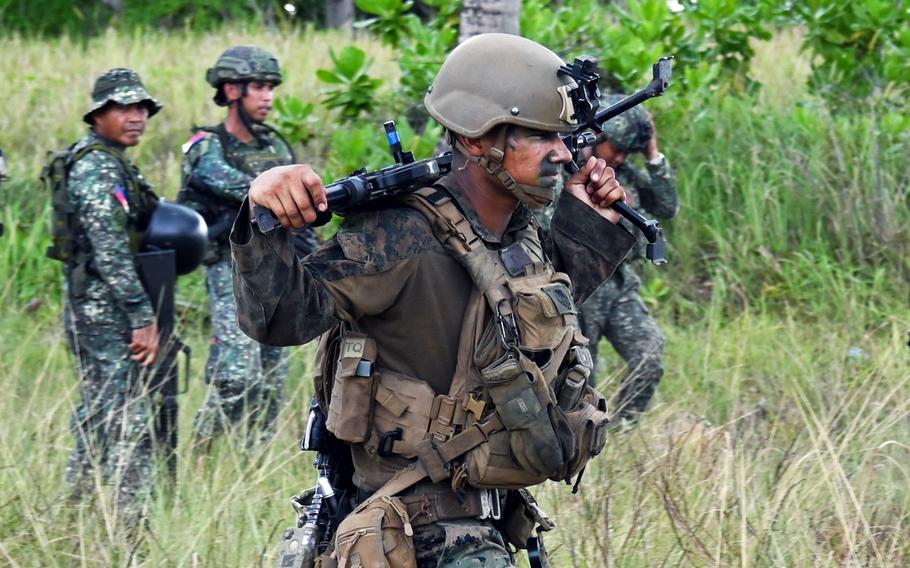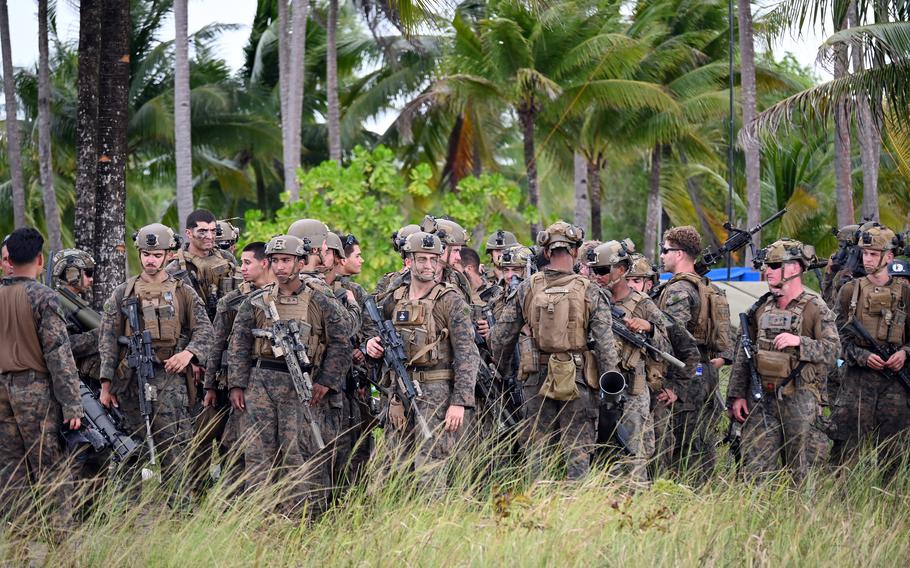
U.S. and Philippine marines train with live fire on the western coast of Palawan, Philippines, April 28, 2025, during the annual Balikatan exercise. (Seth Robson/Stars and Stripes)
A Marine Corps element visiting the Philippines from northern Australia will coordinate with a littoral regiment from Hawaii and command an Osprey squadron from California during the upcoming Kamandag exercise.
Between 1,500 and 2,000 members of Marine Rotational Force-Darwin will join 12 days of regional defense training at sites across the Philippines during the annual exercise that begins May 26.
The Americans will train alongside Philippine and South Korean marines and members of the Japan Ground Self-Defense Force, according to a Wednesday news release from the rotational force.
One hundred members of the force’s command element will coordinate with Marines from Hawaii and California during the drill, Capt. Johnny Fischer, a spokesman for the force, said by email Friday.
The rotational force has had troops in the Philippines since March, and in April sent command and logistics elements to the western island of Palawan for the Balikatan exercise. It will coordinate with additional formations during Kamandag, the release said.
Kamandag focuses on amphibious drills and takes place during heightened tensions between Manila and Beijing, whose coast guards have clashed over disputed territory in the Philippines’ exclusive economic zone.
The command and logistics Marines arrived with their gear from Australia by U.S. Army landing craft and Marine Corps C-40 Clipper airlifter, Fischer said.
The movement from Darwin to Palawan wasn’t just about getting there fast, rotational force commander Col. Jason Armas said in the release.
“It was about getting there ready and able to persist where other formations cannot,” he said. “This exercise validated our ability to serve as a forward headquarters, capable of command-and-control across vast maritime terrain, integrated with partner and allied forces.”
The command element, in the role of I Marine Expeditionary Force Forward, will coordinate with the 3rd Marine Littoral Regiment on the Philippines’ main island of Luzon and command and control Ospreys of Marine Medium Tiltrotor Squadron 364, Fischer said by phone Friday. The littoral regiment is from Marine Corps Base Hawaii and the tiltrotors are from Camp Pendleton, Calif.
The Ospreys — deployed to Clark Air Base on Luzon — have been transporting Marines around Palawan in recent weeks, the rotational force’s operations officer, Lt. Col. Douglas Price, said by phone from the Philippines on Friday.
“It’s very different to California or Darwin — heavy jungle terrain,” he said of training in the islands. “It’s learning to adapt to the jungle and the water and humidity.”

U.S. Marines gather after live-fire training during a Balikatan drill on the western coast of Palawan, Philippines, April 28, 2025. (Seth Robson/Stars and Stripes)
The rotational force had 500 Marines training with Philippine troops and 260 Australian soldiers on Palawan during Balikatan. The Australians, from 5th/7th Battalion, are departing and won’t join Kamandag, Price said.
The Marines spend about a week in the field at a time, subsisting on Meals, Ready to Eat and using mosquito nets to stave off wildlife. When they come back from the field they stay in air-conditioned tents and get hot meals on Philippine facilities, Price said.
They’ve been moving between Puerto Princesa, the largest city on Palawan, and training sites near Rizal, five hours’ drive south. The Marines can take liberty in Puerto Princesa, where there are large American-style shopping malls.
The command element will move from Puerto Princesa to the Philippine marine headquarters at Fort Bonifacio in Manila for Kamandag, Price said.
During the exercise, participating forces will demonstrate expeditionary advanced base operations, he said, referring to the employment of mobile, low-signature and relatively easy to sustain forces in austere locations.
Kamandag will also focus on amphibious integration, maneuvering close to shore and humanitarian operations across Luzon, Palawan, Tawi-Tawi and Batanes islands, according to the rotational force news release.